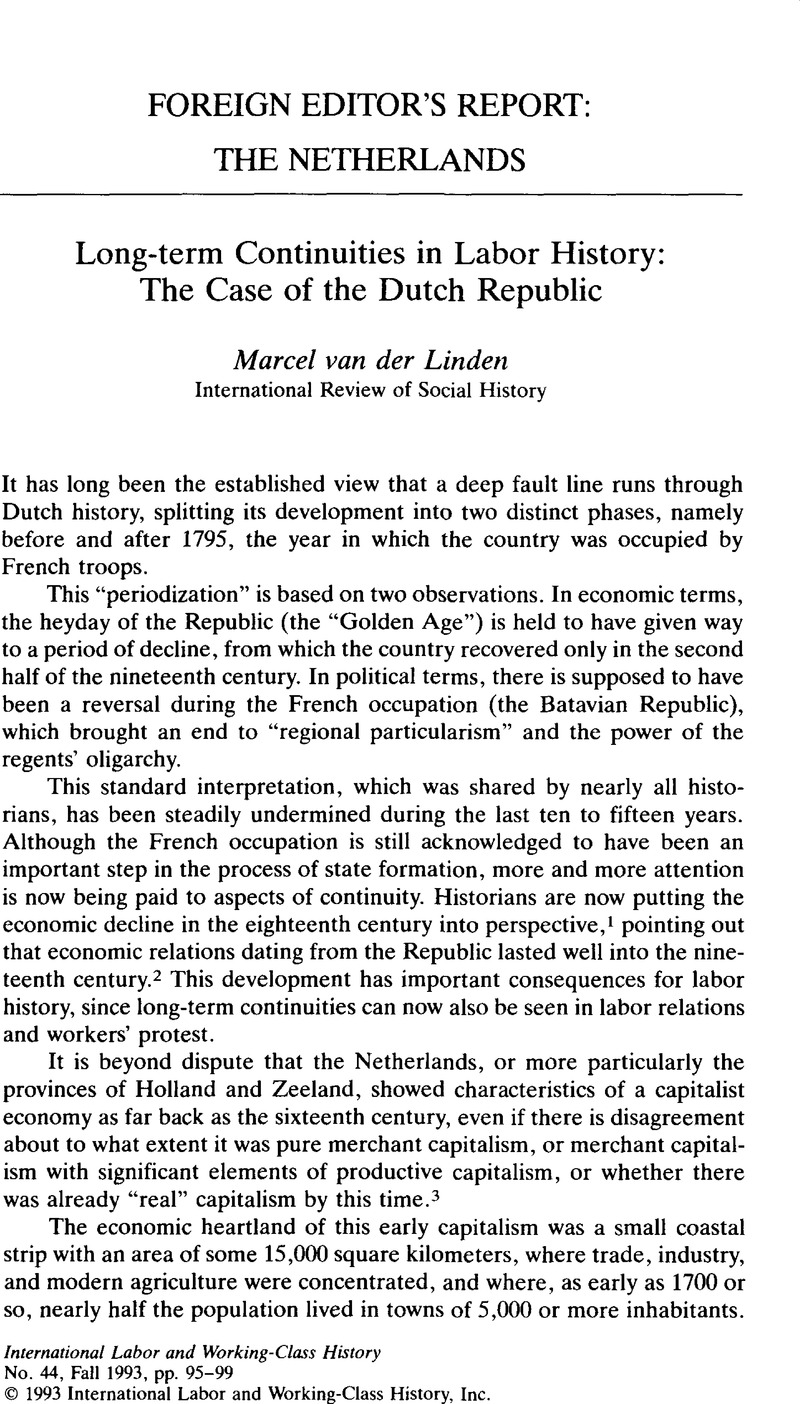No CrossRef data available.
Article contents
Long-term Continuities in Labor History: The Case of the Dutch Republic
Published online by Cambridge University Press: 16 December 2008
Abstract

- Type
- Foreign Editor's Report: the Netherlands
- Information
- Copyright
- Copyright © International Labor and Working-Class History, Inc. 1993
References
NOTES
1. There are three hypotheses about the economic development of the Republic after its heyday in the seventeenth century. These are: a deep decline between 1670 and 1750, followed by a certain amount of recovery in the second half of the eighteenth century (Jan de Vries); stabilization or stagnation between 1700 and 1780, followed by absolute decline after 1780 (Johan de Vries); and economic growth between 1695 and 1805–1860 (J. C. Riley). Of these three assumptions, the second probably agrees best with the facts. See Jan Luiten van Zanden, “De economie van Holland in de periode 1650–1805: groei of achteruitgang?” Bijdragen en Mededelingen betreffende de Geschiedenis der Nederlanden 102 (1987):562–609.
2. van Zanden, Jan Luiten, Arbeid tijdens het handelskapitaltsme. Opkomst en neergang van de Hollandse economie 1350–1850 (Bergen, 1991)Google Scholar, published in English as The Rise and Decline of Holland's Economy (Manchester, 1993).Google Scholar
3. For an overview of some main themes of the discussion, see van der Linden, Marcel, “‘Vaderlandse geschiedenis,’ anders gezien. Het marxisme, de Opstand en de Republiek,” Kritiek 1 (1991): 107–38;Google Scholaridem, “De voorgeschiedenis van het industrieel kapitalisme in Nederland,” Kritiek 2 (1992):273–81.
4. Posthumus, N.W., De geschiedenis van de Leidsche lakenindustrie, 3 vols. (The Hague, 1908–1939).Google Scholar
5. de Vries, Jan, “An Inquiry into the Behaviour of Wages in the Dutch Republic and the Southern Netherlands, 1580–1800,” Acta Historiae Neerlandicae 10 (1978):79–98. Wallerstein's thesis can be found in his The Modern World-System, I., Capitalist Agriculture and the Origins of the European World-Economy in the Sixteenth Century (New York, 1974), 84.CrossRefGoogle Scholar
6. De Vries, “An Inquiry,” 82, 89.
7. For a summary in English of Dekker's research in this area, see his article “Labour Conflicts and Working-Class Culture in Early Modern Holland,” International Review of Social History 35 (1990):377–420.CrossRefGoogle Scholar
8. Dekker, Rudolf, “Handwerkslieden en arbeiders in Holland van de zestiende tot de achttiende eeuw: Identiteit, cultuur en protest,” in Cultuur en maatschappij in Nederland 1500–1850, ed. Boekhorst, Peter te, Burke, Peter, and Frijhoff, Willem (Meppel, 1992), 109–147.Google Scholar
9. “[The] English word strike was originally a Dutch seaman's term, strijken, meaning striking the sails of a ship.” Dekker, “Labour Conflicts,” 139.
10. Dekker, “Handwerkslieden en arbeiders,” 139.
11. This second segment together with the first in fact formed a single split labor market. Light is shed on the relation between the two segments by van Leeuwen, Marco H.D., Bijsland in Amsterdam, Ca. 1800–1850. Armenzorg als beheersings- en overlevingsstrategie (Zwolle, 1992);Google Scholar and Knotter, Ad, Economische transformatie en stedelijke arbeidsmarkt. Amsterdam in de tweede helft van de negentiende eeuw (Zwolle, 1991).Google Scholar
12. Jan Lucassen, “The Place of Labour. Early Modern Economic Development of the Netherlands in a European Perspective,” paper presented at a seminar of the Netherlands Institute for Advanced Study, Wassenaar, 25–26 November 1992. Also see idem, “The Netherlands, the Dutch and Long Distance Migration: Late Sixteenth to Early Nineteenth Centuries,” in In Search of a Better World: European Overseas Migration 1500–1800, ed. N. Canny (Oxford, forthcoming).
13. Lucassen, Jan, Naar de kusten van de Noordzee (Gouda, 1984);Google Scholar a slightly shortened English version was published as Migrant Labour in Europe 1600–1900: The Drift to the North Sea (London, 1987).Google Scholar
14. Lucassen, Jan, Jan, Jan Salie en diens kinderen (Amsterdam, 1991), 36.Google Scholar
15. The first signs of change are Bruijn, Jaap R. and Lucassen, Jan, eds., Op de schepen der Oost-Indische Compagnie. Vijf artikelen van J. de Hullu (Groningen, 1980);Google Scholarvan Royen, Paul C., Zeevarenden op de koopvaardijvloot omstreeks 1700 (Amsterdam, 1987);Google Scholar and idem, “Manning the Merchant Marine: The Dutch Maritime Labour Market about 1700,” International Journal of Maritime History 1 (1989):1–28.
16. But see van Eyck, E.S.van Heslinga, , Muiterij. Oproer en berechting op de schepen van de VOC (Bussum, 1980).Google Scholar
17. Dekker, Rudolf, Holland in beroering. Oproeren in de 17de en 18de eeuw (Baarn, 1980);Google Scholaridem, “Women in Revolt. Collective Protest and its Social Basis in Holland,” Theory and Society 16 (1987):337–62.
18. Lucassen, Jan, Jan Salie en diens kinderen, 28–37; Jacques van Gerwen and Jan Lucassen, “Mutual Societies in the Netherlands from the Sixteenth Century to the Present,” paper presented at the conference “Un passé riche d'avenir,” Paris, 1–3 December 1992.
19. See, for example, Huisman, Kerst, “‘welke dan gewoonlijk de oproerlingen zijn…’ De spontane stakingsbeweging in de Friese venen tot 1888,” in Ferdinand Domela Nieuwenhuis. De apostel van de Friese arbeiders, ed. Frieswijk, J., Kalma, J.J., and Kuiper, Y. (Drachten and Leeuwarden, 1988).Google Scholar




